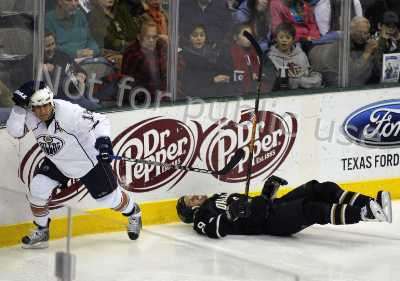Most Common Injuries in Ice Hockey Most common injuries occur from direct trauma, or a forceful hit. The most often trauma is caused from a collision with another player, or a collision into the boards. According to Thomas Schmidt 80% of injuries are from trauma. Other types of trauma are hitting the ice, falling into the boards or net, and getting hit with a stick or puck. Some more common injuries are lacerations. Lacerations can happen anywhere on your body. You can sometimes get cut through or around your pads as well. Cuts can come from skates, sticks, and pucks. Most commonly seen are cuts from sticks. Many professional hockey players get cut in the face because they are not wearing a face mask.  | Career Ending Injuries One of the most common career ending injuries for a National Hockey league player is concussions. Many players end up getting too many concussions and are at risk of seriously hurting themselves. Another career ending injury according to Todd Schmidt is certain blows to the knee. Hockey players rely on their legs to make them into a great player. With great balance and speed and player can make it to the National Hockey League. When players take blows to the knees it puts a lot of stress on the MCL and the ACL. It can even be worse when a player is younger and takes a terrible blow to the knee. The body may never completely heal and a player may never be the same. An injury that is increasing in hockey are injuries to the neck and spine. The game is becoming faster with all of the new rules that were put in place. Since the game is faster the player has less time to react, and has a better chance of getting an injury. Injuries occur to the neck and since when players get hit in the back or they slide akwardly into the boards. These can be some of the most dangerous injuries, because players can end up paralized or possibly dead. |
One reason why National Hockey League players get injured is because they do not always wear their equipment properly. Most players don't wear ear pieces or mouthguards out on the ice. Not only can mouthguards help maybe save a few teeth they can also help to prevent concussions. Most NHL players do not wear throat guards. The only players that are required to wear throat guards are the goalies. Shoulder pads, Pants, and Elbow pads are worn small, or some of the protective padding is removed to help make a player faster or give them more mobility. If all players were required to wear more protective gear, and it was regulated less players would get injured every year. | While players can help to prevent injury, equipment companies are trying to help prevent injuries for players as well. Companies are coming out with new technology helmets and pads all year long. The helmets now can take more of a blow and still help to prevent concussions or other head trauma. Skates are becoming lighter and more durable. With better skates less players will have ankle injuries due to twisting or turning of the ankle. Also, they will not have broken feet from getting hit in the foot with a shot from an opposing player. Goalie pads are probably developing more rapidly than any other pad in the NHL. They are making them lighter and more durable. The lighter the pad is the faster the goalie can move, but the goalie also wants a strong pad that won't break down after a month. All the new development companies are doing is to make players better, but more importantly they are doing it to try and insure the safety of players. |